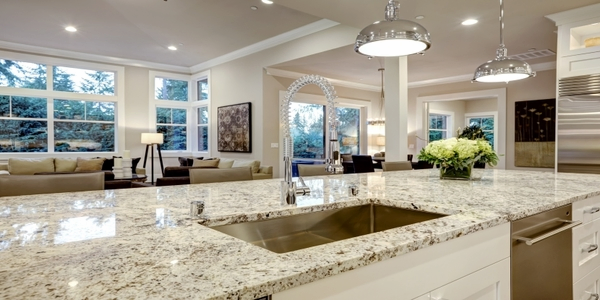
Molly Maid offers expert guidance on safely sanitizing granite countertops to maintain their beauty and hygiene.
|
If you just had new granite countertops installed in your kitchen, congratulations are in order! Your kitchen is finally complete, and ready to use. Best of all, it looks fresh and elegant—an excellent addition to the heart of your home.
While you may have read up on the basic ways to clean granite counter tops, most of the time a simple cleaning is not enough. Since you handle raw poultry, meat, fruit, and vegetables in your kitchen, harmful bacteria like E. coli can spread, affecting the health of you and your family.
To keep your family safe, it’s important to sanitize your granite countertops regularly, in addition to your basic cleaning routine. Unfortunately, sanitizing your granite countertops the wrong way can permanently damage your stone.
Unlike engineered non-porous stone, granite is natural and porous, which means liquid can seep in causing it to stain. To prevent staining, a stone sealant is applied to the granite to help prevent any damage. The problem with most sealants is that many household cleaners—even those claiming to use natural ingredients—can strip them away and leave your countertops vulnerable to permanent stains.
By following a few simple tips, you can go beyond your basic cleaning routine and sanitize your granite countertops without damaging the beautiful finish.
Related Topic: Do Natural Cleaning Products Kill Bacteria?
Disinfectants to Use
Disinfectants containing alcohol are effective at killing germs and bacteria, which make them a good choice for sanitizing. Isopropyl alcohol is a first-aid product that is easy to find at your local grocery store or pharmacy. A 70% isopropyl alcohol product is the best one to use as a cleaner because it has a higher moisture content and stays on surfaces longer, so it has time to kill bacteria. Any mixture higher than 70% evaporates too quickly, so it won’t clean as well.
To complete your disinfecting mixture, you’ll also need an antibacterial dish soap and a one-liter spray bottle. Mix four tablespoons of the alcohol and four drops of the soap into the one-liter spray bottle. Fill the spray bottle with lukewarm water and shake it gently. To clean, spray the mixture onto your countertops and let the solution sit for 3–5 minutes before wiping it down with a soft sponge or cloth.
Disinfectants to Avoid
Abrasive cleaners such as bleach, ammonia, window cleaners, and all-purpose cleaners should never be used on your granite countertops. These harsh chemicals can remove the protective sealant and expose your countertops to deterioration and stains. Even products that claim to be natural should be avoided. For example, vinegar, lemon, and lime are popular alternatives to the stronger cleaners listed above. While they might sound like a fresh and natural alternative to commercial cleansers, they’re highly acidic and can strip your sealant and remove your granite’s shine.
Related Topic: How to Create a Daily, Weekly, and Monthly Cleaning Schedule You can Live With
Sponges and Cloths to Use
Only microfiber cloths, washcloths, or non-scratch sponges should be used on your granite countertops. These materials are both gentle and absorbent, so you can be sure they’ll get the job done without harming your stone. White washcloths are preferable to ensure that there’s no chance the dyes used to create colored cloth will seep into your counters. However, colored washcloths are OK to use if they’re not new and you’re confident the dye is no longer seeping out of the cloth.
Sponges and Cloths to Avoid
No matter how deep you intend to clean, don’t use scouring pads, steel wool, and scrub-sponges on your countertops. Just like the harsh chemicals, these rough cleaning tools will tear away your sealant and can cause visible scratches and streaks on your granite countertops. And even though disinfectant wipes may seem like an easy, time-saving solution, they also contain harmful chemicals, such as citric acid, that will strip away at your sealant and leave your countertop vulnerable to damage.
More Deep Cleaning Tips
Home improvements and renovations often inspire us to keep our home looking pristine. Although deep cleaning each area of your home might seem overwhelming, mapping out specific rooms and tasks can help. Check out the Molly Maid Deep Cleaning Checklist for more deep cleaning tips and download the PDF version to help you set up your routine. And contact your local Molly Maid to learn more about the cleaning services we offer.
